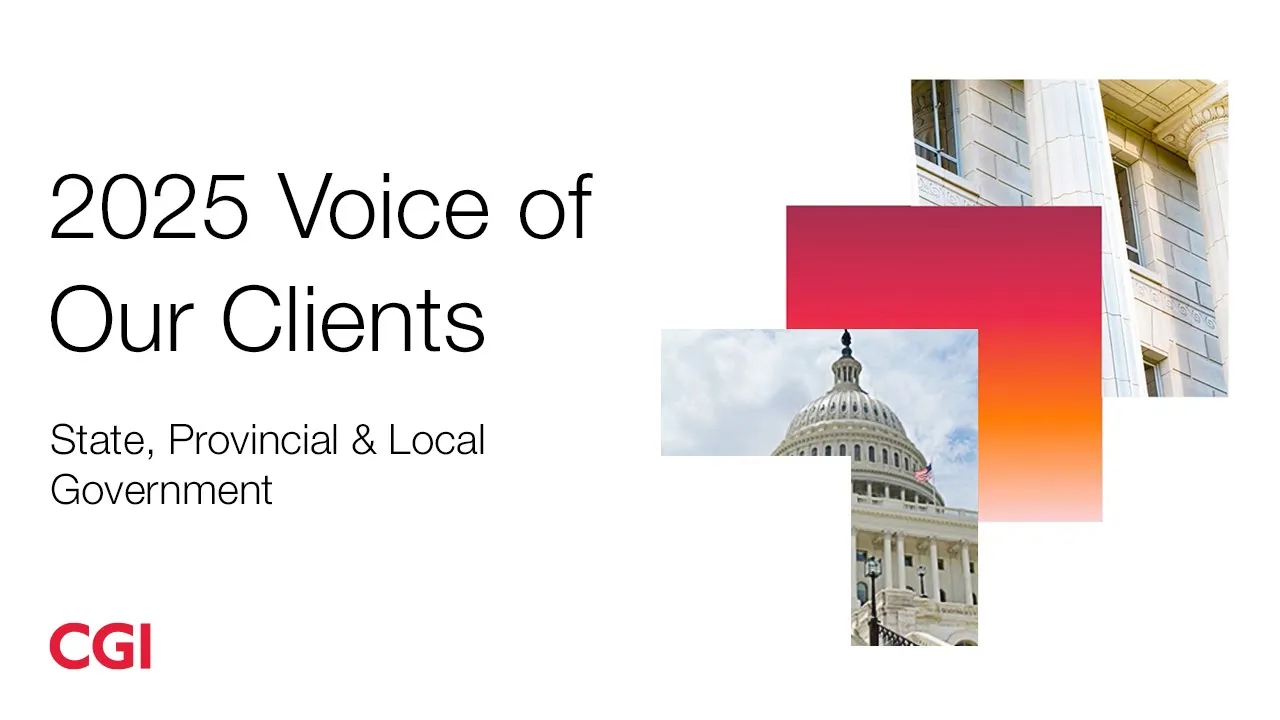How are state, provincial and local governments modernizing services, navigating legacy systems and addressing workforce and budget constraints?
In this video, we explore insights from the 2025 CGI Voice of Our Clients research, based on interviews with 158 government executives on the challenges and priorities shaping public sector transformation.
From cloud migration to AI-powered innovation and citizen-centric service delivery, discover how forward-looking leaders are modernizing with purpose, building trust and improving outcomes for communities.
Key trends covered in this video:
- Modernization of legacy systems and cloud adoption
- Digital strategies to improve service delivery and resilience
- Talent shortage and workforce strategies
- Cross-agency collaboration and governance reform
- Data governance and AI readiness
Learn from real-world examples—like how Indigenous communities in Canada are using AI and digital twins to strengthen fire safety and public service resilience.
At CGI, we help governments modernize legacy systems, align technology with community needs and deliver trusted digital services that drive lasting impact.
Video transcript
- The modernization challenge in government
-
State, provincial and local government leaders face growing pressure to modernize while navigating legacy infrastructure, limited budgets, rising citizen expectations, and rapid technology and workforce shifts.
Transformation goes beyond implementing new technologies. It's about reimagining how services are delivered with more speed and quality.
- Fragmented governance remains a major barrier
-
One of the biggest obstacles: fragmented governance. Silos between agencies, disconnected departments, and shifting political priorities often stall progress and block transformation.
I believe the problem that they're encountering is just the amount of work. There are data sets scattered throughout governments.
Governments have many ministries. All those ministries store personal data.
The source of truth for that data is not necessarily easy to find, and you have a number of ministries that have different objectives and different priorities.
I think once you get a good data governance and a good data foundation, things like transformation and modernization are going to become a lot easier.
- Top trends driving public sector transformation
-
According to our Voice of Our Clients research with 158 state provincial and local government leaders, progress is happening.
Forward-looking leaders are building trust and resilience, proving that sustainable transformation is not only possible, but already underway.
Our research demonstrates that three trends are shaping the future of the industry. Modernization is no longer optional.
It's foundational.
Many governments still rely on decades old systems.
Cloud migrations, platform upgrades and reducing technical debt are now top priorities for improving efficiency, resilience, and service delivery, while also ensuring citizen data is safe and secure.
Lasting progress depends on stable funding, skilled talent, and effective governance.
Addressing talent shortages and digital acceleration It's no surprise that more than 70% of leaders say technology and digital acceleration are significantly impacting their organizations.
In addition, more than 70% of leaders say talent shortage as a key challenge. Leaders report an urgent need to attract and retain technology professionals. Hybrid work, external partnerships and upskilling programs are gaining traction, but workforce gaps remain a top barrier to transformation.
- Meeting citizen expectations through digital platforms
-
Mobile first and self-service digital platforms remain a priority.
Citizens expect better digital services from government organizations, but legacy systems continue to slow progress as a key barrier to digitization. An increase from last year.
Together, these pressures are reshaping not just what governments do, but how they do it.
Connecting technology, talent, and service models in smarter, more integrated ways.
- Agile teams gain ground in government transformation
-
We're seeing 80% of organizations are moving towards agile teams, with 20% reporting that they're highly agile.
And the fact that we're seeing so many moving towards agile teams just underscores the criticality of using these types of organizational models to redevelop and modernize applications.
- Embedding cybersecurity into government systems
-
From a proactive perspective, you need to be looking at everything from data to infrastructure, to your development practices.
You need to be incorporating cybersecurity right from the beginning.
As you develop applications, you need to build your security into the design.
As you build these applications and deploy them, you need to make sure that cybersecurity is thought of through the entire process.
- Use case: AI for fire safety in Indigenous communities
-
Canada's First Nations communities needed a safer, smarter approach to fire prevention.
We partnered with a leading Indigenous software provider to launch an AI-powered pilot aimed at improving fire safety and insurability.
In phase one AI and machine learning was used to create digital twins of buildings, detecting fire safety assets with more than 90% accuracy.
Phase two added real-time monitoring through Internet of Things sensors and cloud systems, to support proactive fire response and data-driven safety management.
By aligning digital innovation with community health and infrastructure needs, this initiative strengthens emergency preparedness and improves insurance access.
It shows how AI-enabled public service solutions can advance equity, resilience, and measurable outcomes supporting data-driven transformation across governments and communities.
- A long-term commitment to smarter government
-
Modernization isn't a one-off initiative.
It's a long-term commitment.
Leading state, provincial and local governments align technology with workforce strategies, data, and evolving community needs.
So what's next for your organization?
Start by modernizing legacy systems with secure cloud platforms.
Strengthen data governance for AI readiness.
Focus digital investments on faster service, better access and stronger community resilience.
Prioritize cross-agency collaboration and invest in workforce strategies that attract, retain, and upskill digital talent.
Transformation isn't optional. It's how governments build trust, drive efficiencies, and shape the future of public service.




